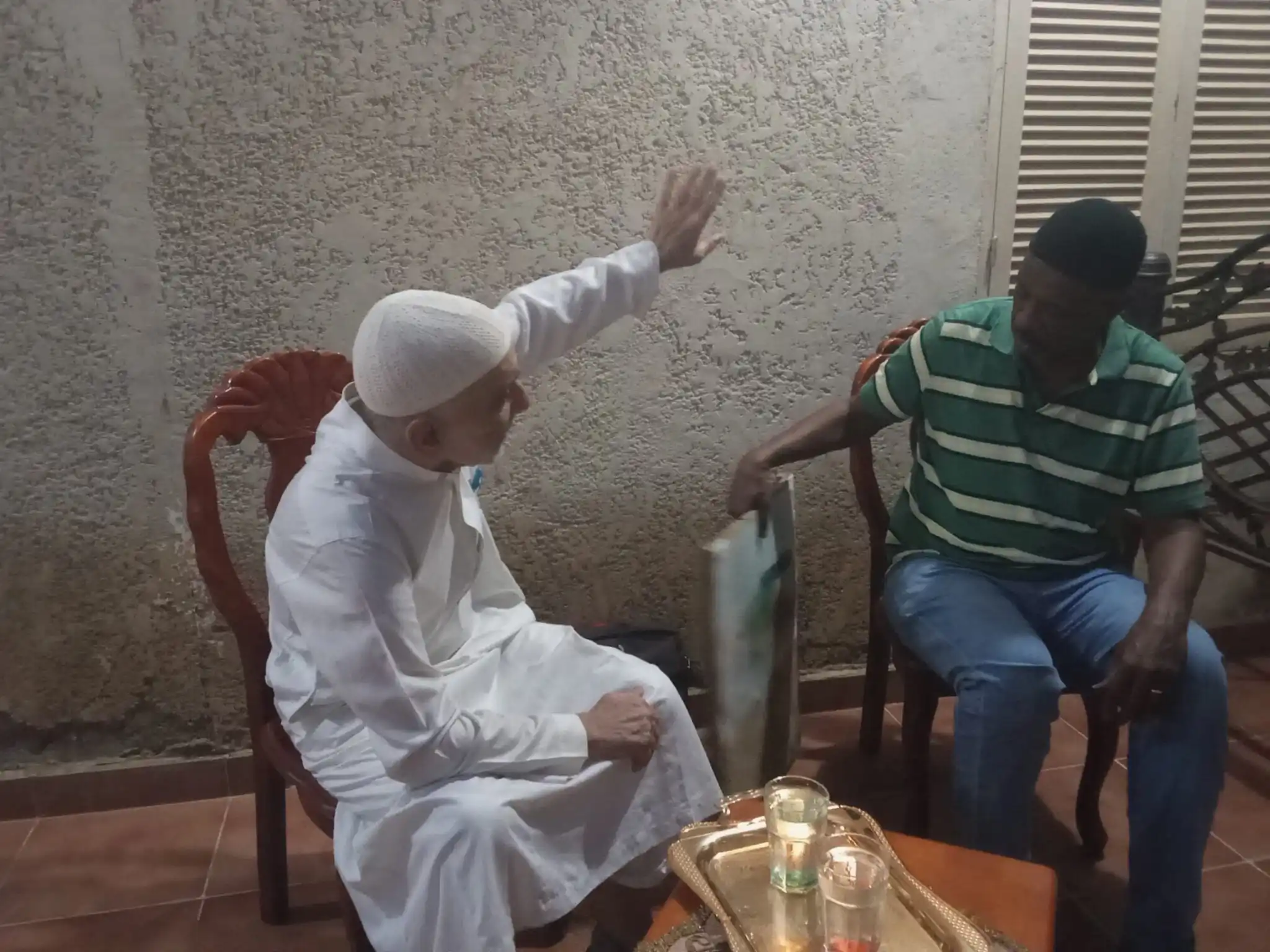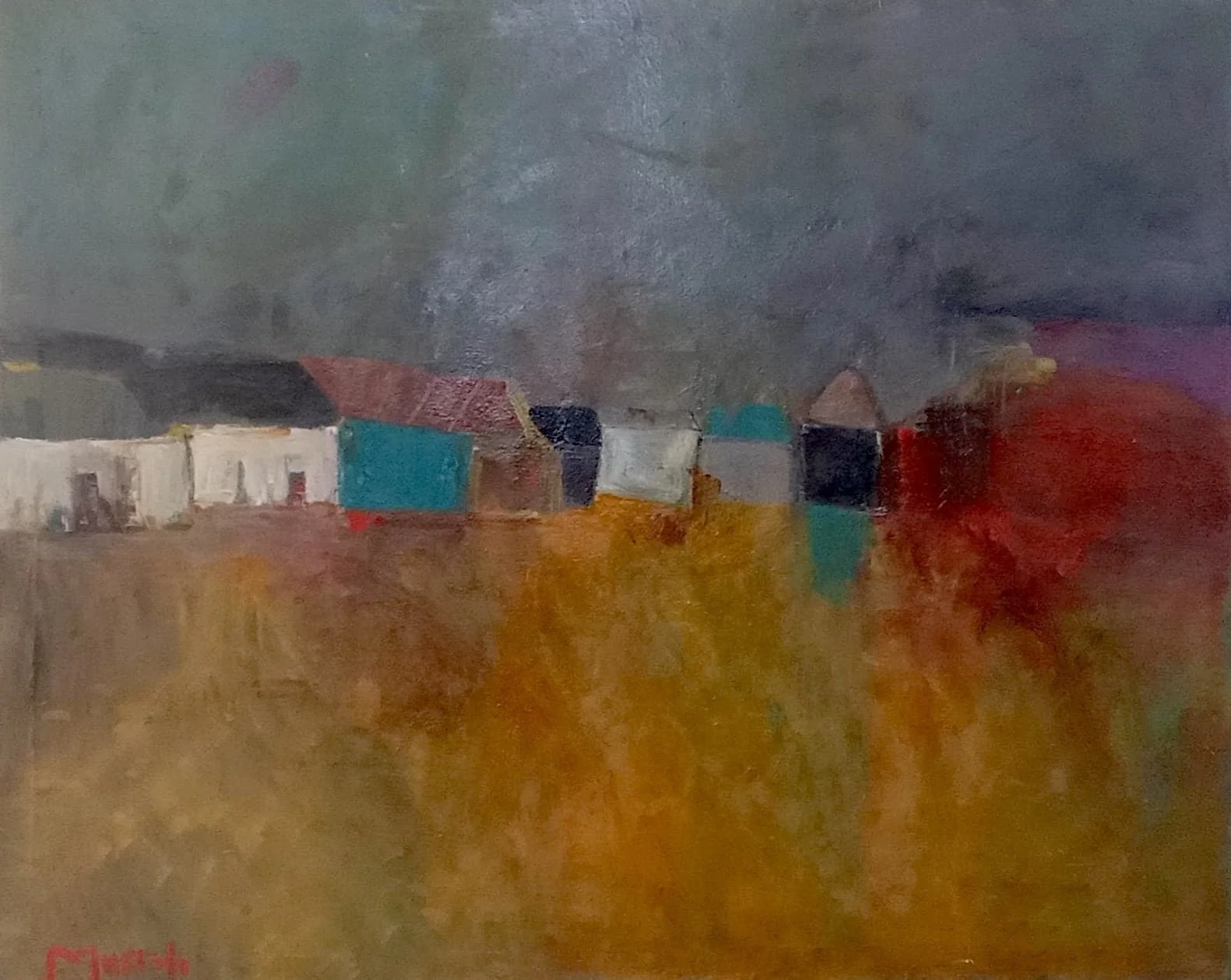Author Hassan Al-Nasser
From memories to memories, An interview with visual artist Mustafa Hussein Salem

We met at his house in Port Sudan, in the airport neighbourhood, in a summer atmosphere. He was wearing a white robe and black glasses. He welcomed us in an authentic Sudanese way, in the foyer of his house, where paintings dating back to the days of his studies and youth and then the days of isolation from going out into society as a visual artist, where he had remained in his house for more than a decade, his office in the College of Education, and his paintings. Mustafa Hussein Salem was born in the city of Tokar in eastern Sudan. His origins go back to the city of Suakin, but he grew up in Tokar.
We conducted this dialogue with him as the first documentary work to be done about Mustafa Hussein Salem and published on the Internet. We want to thank the artist Faisal Taj Al-Sir for facilitating this meeting with Hussein, in addition to his participation in the dialogue by adding to the questions and bringing the idea closer to Mustafa Hussein Salem.
…
Mustafa, tell us about your upbringing and reception of the arts, especially since you define yourself as a modern visual artist in a modern city, but receiving modern plastic art there have some difficulties, as we see in the absence of galleries, for example, or art centres other than those that have appeared recently?
I grew up in the city of Tokar. The city was a large population centre for the agricultural project. I studied primary and middle school there, but the family would move from Tokar to Sinkat and then to Port Sudan due to the nature of the atmosphere and also families in the sixties, but our origins go back to The city of Suakin, which was abandoned due to the emergence of Port Sudan at the turn of the century, and also the emergence of the agricultural project in Tokar.
And art in your life. How did you begin to receive it?
In the sixties, the arts received a degree of interest, especially in primary schools, which used to bring professors and teachers from different regions in Sudan. There were classes taught about the arts in addition to the materials used in drawing, as they made it easier for students to acquire and work with them, as there were Stores for art materials and encouragement to create art. When I went to middle school, the situation was different, as interest in art increased. We also produced issues of magazines and sent them to officials.
In high school in Port Sudan, the subjects we receive about arts increased, in addition to the attention from teachers such as Abdel Basit Al Khatim, Bakri Bilal, Abdel Rahman Jarkali, Muhammad Mahmoud, and Suleiman Abdel Qader. I remember that Bakri Bilal held the first exhibition at the Red Sea Hotel, and that was in the seventies, I believe.
Then, after that, the passion turned into the necessity of going to university to study arts, and indeed, in the mid-seventies, I went to the College of Fine Arts.

The university period and engagement with art as an academic course. How can Mustafa Hussein Salem express it after these years?
The university stage was certainly highly influential in my formation in terms of the discussions that took place in the college, in addition to the environment presented at the college, as there was a forum that brought together students, whether those in the college or outside it, as well. The college was very active and broad as well. I think that the college produced about 20 wall newspapers, and they were not simple newspapers but rather rich in the arts and also in artistic and political theoretical opinions. These opportunities provided us with the ability to develop our artistic vision.
Especially since I come from a family that was not interested in the arts, I found my own space in shaping my relationship with what is around me through art, which is something that goes back to Sudan itself through the state’s interest at that stage in artists, which strengthened our capabilities in art, and this is what appeared in the current scenes in Fine Art in Sudan, and also in the materials that are used in Sudan during that stage.
At university, we were interested in political issues such as the issues of Africa and South Africa and the Vietnam War. But at the level of art, the schools of thought that influenced us were the Khartoum School, but I cannot say that I am influenced by it myself. I do not think that I belong to a specific school, and this is evident in some of the work that I do.
Sometimes, I work realistically, but I turn against it when I read poetry, for example, and then I return to abstraction. For me, the composition is more poetic than what the poetry itself says.
The city’s impact on you, especially since I learned that your relationship with Port Sudan as an artist is tense?
I do not feel that I am part of the imagination of Port Sudan nor part of its space. I am influenced by Suakin, and I have done many works whose basic theme was Suakin, in addition to being influenced by Khartoum as a city that is part of the imagination in which I was formed. Therefore, I take care of my relations with Khartoum, especially since I worked there for a period in the Teacher Training Institute in Omdurman, which brought me close to the college. I was part of its community for a while before moving to Bakht al-Rida and then to Kassala. Then, I returned to Port Sudan.
In Khartoum, I did not live in a place (joking!) Rather, I was walking. Frankly, I lived in the Al-Zuhur neighbourhood in the centre of Khartoum, and the neighbourhood had some artists with whom we chatted and discussed, which deepened my relationship with the arts and the college as well. Not only that, but the neighbourhood was also beautiful, it had an artistic atmosphere and mood and was suitable for any creative person to live in.
I also worked in journalism, where I was drawing for the Armed Forces newspaper. There was a page containing some poems that I was drawing. My experience at Bakht al-Rida was not satisfactory, as I stayed there for a few months until I left for personal reasons.
How can we look at the arts between now and then through your previous exhibitions?
I held the first exhibition in Tokar in 1969 while we were in high school, but during my entire artistic career, I held about ten exhibitions. I remember the first time I entered an exhibition in 1967 at the Red Sea Hotel, I think, by Mr. Bakri Bilal. I remember that Mr. Schiller, the English teacher, bought a painting worth five pounds, and it was a strange event at that time.
My first exhibition was titled “From Memories to Memories”, and my last exhibition was “Transformations of Wesg Ibn Babawa between Yesterday and Now”. Also, I had an exhibition “As My Friend The Wind” at The Meridian, and another at the Hilton Hotel in 1986, and I remember that I even sold my graduation paintings that were about Suakin.
Why are you attached to Suakin?
Suakin is the city of magic. I have not lived there, but I am very attached to it. I do not know why Suakin, a picturesque and magical area, was neglected.
